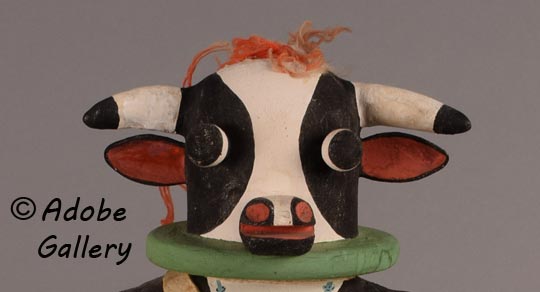Hopi Pueblo Cow Kachina Doll, Wakas Katsina [SOLD]
+ Add to my watchlist Forward to Friend
- Category: Traditional
- Origin: Hopi Pueblo, Hopituh Shi-nu-mu
- Medium: wood, paint, feathers, hide
- Size: 16-½” tall
- Item # 26311 SOLD
The Wakas Katsina Doll: A Symbol of Hopi Artistry
This oversized Wakas Katsina doll, crafted in the 1950s by an unidentified Hopi artist, is a remarkable representation of mid-century Katsina doll carving. The depiction of Wakas, or cow, is notably elaborate and detailed, with his eyes, ears, horns, and snout dramatically protruding from his mask, commanding the viewer's attention while maintaining a friendly and approachable demeanor.
Standing comfortably on two feet, this Wakas doll can also be displayed hanging from a wall. He is adorned with a traditional turquoise nugget necklace with pendant jacla, a concho belt, an embroidered sash, and a loin cloth over his kilt. Additional embellishments of leather and feathers complete the artist's meticulous presentation, reflecting the rich cultural heritage of the Hopi people.
Wakas, first appearing in the Hopi pantheon of Katsinam around 1900, symbolizes the profound relationship between the Hopi and the Katsina spirits. This relationship, akin to a deep friendship, involves an exchange of special favors. The Hopi show their respect through offerings of prayer feathers and meals, and in return, they receive blessings from the Katsina spirits.
Animals play a significant role in Hopi culture, serving as advisors, healers, and assistants. They have helped the Hopi overcome adversity, cure diseases, and navigate dangerous situations. Some animals are considered warriors, aiding the Hopi in adopting their strength and courage. It is believed that all animals can remove their skins at will, appearing as men when they do so. These animal spirits, the Hopi's closest neighbors, are always willing to assist when approached respectfully and asked for help, reinforcing the deep bond between the Hopi and the natural world.
This Wakas Katsina doll is not just a piece of art; it is a symbol of the Hopi's spiritual beliefs, their respect for nature, and their artistic traditions. It serves as a testament to the enduring legacy of the Hopi culture and its profound connection with the spiritual and natural world.
Condition: very good condition but missing the gourd rattle from his right hand.
Provenance: this Hopi Pueblo Cow Kachina Doll, Wakas Katsina is from the collection of a gentleman from California
Reference: Hopi Kachinas: The Complete Guide to Collecting Kachina Dolls by Barton Wright
TAGS: Kachina – Katsina Doll, Hopi Pueblo

- Category: Traditional
- Origin: Hopi Pueblo, Hopituh Shi-nu-mu
- Medium: wood, paint, feathers, hide
- Size: 16-½” tall
- Item # 26311 SOLD
Adobe Gallery Recommended Reading
Adobe Gallery Recommended Items
If you are interested in this item, we would also like to recommend these other related items:



